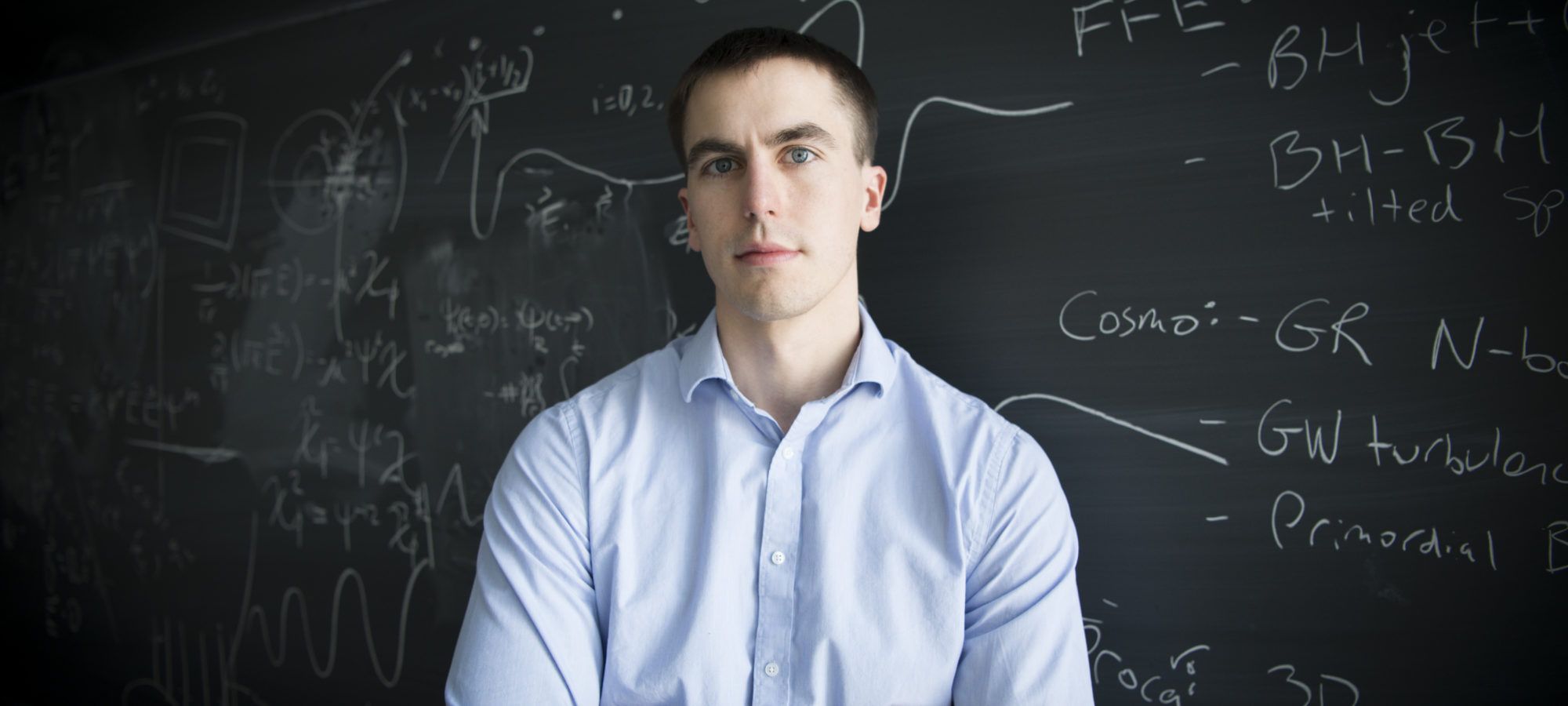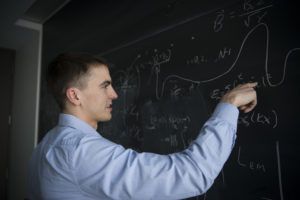People of PI: Will East, guided by gravity
How one of the biggest discoveries in recent science brought a rising young researcher to a new frontier of his own.
Take a self-guided tour from quantum to cosmos!
How one of the biggest discoveries in recent science brought a rising young researcher to a new frontier of his own.

You could say the stars aligned for astrophysicist Will East on February 11, 2016. The collapsed stars, anyway.
It was on that day that one of the most important astrophysics discoveries in decades was unveiled to the world, and that East made a decision that would change his own trajectory.
He got up around sunrise that morning. East was a postdoc at the Kavli Institute for Particle Physics and Cosmology at Stanford, California, and he wanted to watch a press conference being webcast from Washington, DC. The time difference meant an early start, but East had heard rumours that it would be worth it.
The gossip was that LIGO, the Laser Interferometer Gravitational-Wave Observatory, had detected the merger of two black holes – regions of intense gravity formed by the collapse of stars – and had measured the shockwaves created in the collision. It was exactly the kind of phenomenon East was investigating and modelling as a strong gravity theorist. If the rumours were true, it would be a landmark breakthrough that would shape the field and his research in it.
That wasn’t the only thing on his mind, though. His email inbox held two job offers for new research positions, including a Director’s Fellowship at Perimeter Institute. The 30-year-old resolved to watch the webcast first, spend some time chatting with colleagues about the significance of the announcement, and then send the emails that would determine the next stage his scientific career.
He joined several dozen of his coffee-sipping peers in a Stanford auditorium just before 8 am to watch the webcast from Washington. On the big screen, after the standard formalities and thank-yous were done, LIGO Executive Director Dave Reitze smiled from the podium and said three words that sparked applause in Washington, at Stanford, at Perimeter, and at similar gatherings around the world: “We did it.”
The LIGO team had, after decades of planning and constructing the most sensitive measuring tool ever invented, detected ripples in spacetime created by a cataclysmic merger of two black holes. The gravitational waves produced by the merger, first predicted a century prior by Einstein (who insisted they would be too faint to ever be measured experimentally), had triggered LIGO’s sensitive detector as they passed though Earth on a billion-year journey across the universe.

“It seemed almost too good to be true, that the LIGO signal would be so loud and clear,” East recalls. “Maybe I’m biased, but I think the detection of gravitational waves is the most exciting discovery in my life, maybe the most exciting discovery that ever will happen in my lifetime. It was the beginning of gravitational wave astronomy – a new field with new possibilities.”
Those possibilities, he understood, included using gravitational waves as a new tool for tackling profound questions in astrophysics and cosmology, from the foundations of general relativity to understanding what happened at the beginning of the universe.
He knew that his own specialty – using numerical tools to explore the dynamics of spacetime in strong gravity phenomena – could serve as a bridge between gravitational wave astronomy and those related questions. He wanted put himself in a position to help build those bridges. So when he sat down at his computer later that day, East sent a letter of acceptance to the place where he felt he’d be able to do his best work in the newly dawned gravitational wave era: Perimeter Institute.
“Perimeter reminded me of a cool start-up, but for physicists,” he said. “The design of the building, all these spaces for collaboration, the restaurant where everyone eats together – it’s different than other places for doing physics.”
He moved with his wife to Waterloo in the fall of 2016 to begin his term as a Director’s Fellow, a postdoctoral position with the potential to evolve into a place on Perimeter’s faculty. After a year of collaborating with Perimeter researchers, that evolution occurred: he was hired as a full faculty member and a key player in Perimeter’s newly formed cosmology research hub, the Centre for the Universe.
Working at Perimeter, surrounded by blackboards full of equations, feels like a perfect fit for East, who taught himself mathematics as a child because he was entranced by the esoteric symbols that filled the books that his father, a software engineer and physics buff, brought to their North Carolina home.
At first, he was drawn to pure mathematics by the joy of solving difficult puzzles (a joy sparked by his trips to math camp as a teen), but as he progressed through his undergrad, he turned his focus to applying mathematical rigour to understanding physical phenomena in the big, bizarre universe. “Math was like a gateway into physics,” he says. “Physics is about something tangible, something real out there.”
He considers himself fortunate to be working in the physics of strong gravity at a time when the field is entering a period of intense activity, with experiments like LIGO and others making measurements of phenomena that were, not long ago, only accessible through pure theory.
He feels he is in the right place, at the right time, to pursue the big questions that keep him up at night. “Fields of physics have their ebbs and flows, but for gravity, with new avenues opening with gravitational waves, it’s a huge thing in my field,” he says. “We’re just beginning to see things we were not expecting to see. I definitely feel lucky that I followed my curiosity to this point.”
Clouds of particles surrounding some black holes could create smaller versions of cosmic strings and provide insights into dark matter, according to research by Perimeter’s William East.
Gravitational wave researchers gathered at Perimeter’s first in-person scientific workshop since the pandemic began.
A round-up of what’s up: the latest news from Perimeter, a look at the recent work of researchers and alumni, gems from the archive, and fun physics for everyone.